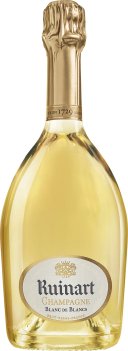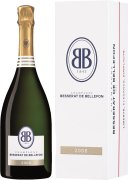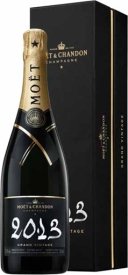Gosset Grand Blanc de Blancs Non-Vintage
Product Information: This Champagne highlights the more mineral characters of the different Champagne varying terroirs. Dialling into the chalky minerality, the Chardonnays are selected from various crus - Avize, Chouilly, Cramant, Villers-Marmery, Trépail - where the chalk breaks through to the surface in the Montagne de Reims, Vallée de la Marne and the Côte des Blancs. Earthy mineral aromas, very refined, delicate and attractive overall, with aromas of white flowers, citrus and a trace of honey. Lovely tension! As crisp and lively as it gets. Bottled at the end of the spring following the harvest and with 4 years minimum ageing in the cellars. The dosage is a low 7g/l adjusted with precision to preserve the balance between freshness and fruit without masking the wine’s character and purity. Maker: The oldest Wine House in Champagne: Aÿ 1584 The history of the Gosset family goes back five centuries to Jean Gosset (1484-1556), “Lord of Aÿ and Mareuil”, who was the first official ancestor in the lineage. The origins of “Maison Gosset” itself date back to the year 1584 when Pierre Gosset, Lord and Alderman of Aÿ, decided to set up a négociant business. 16 generations, all of direct lineage, have continued to build upon his work in Aÿ-Champagne and ensured that Champagne Gosset’s savoir-faire, lives on. Towards the end of 1993, the Champagne Gosset became part of the family-owned Renaud-Cointreau group which has since made it its mission to preserve the Gosset style. In the late 20th century, Champagne Gosset’s association with the Cointreau family, as well as the birth of the Gosset Celebris vintage cuvées, propelled the Champagne House to be amongst the most prestigious Champagne Houses. The unique bottle Jean Gosset first used the antique bottle that would become the emblem of the Gosset Champagne House in 1760. This bottle is an exclusive model that used to be part of the family’s collection of ancestral bottles. It owes its name to the “antique glass” colour of the glass paste from which it is produced. This elegant bottle is bears a neck label known as the “necklace medallion” named after Albert Gosset (truly one of a kind in the Champagne region), is instantly recognisable. Philosophy: Gosset is dedicated to crafting wines with perfect balance between freshness and distinctive character. Each cuvée reflects the region’s diverse terroirs, sourced from 140 hectares of Champagne vineyards. Their unique vinification process preserves natural fruit freshness and enhances aromatic expression, resulting in Champagnes with great mineral freshness, deep varietal character, and excellent aging potential. This approach delivers rich, balanced, and complex drinking experiences for connoisseurs and enthusiasts alike. Nose - Chalky, Savoury, Herbaceous Earthy mineral aromas, very refined, delicate white flowers, marjoram and floral honey. Palate - Lemon, Sherry Notes, Energetic Nervy, crisp and lively on the palate. Lemon peel, white peach, subtle nougat and sherry complexity. Young and fresh overall. Finish - Chalk, Sea Spray, Minerality A clean, appetising finish and aftertaste. Lip-smacking.
Agrapart & Fils 7 Crus Extra-Brut Non-Vintage
Product Information: The NV Brut 7 Crus is a very pretty. Bright, mineral and intensely vibrant, the 7 Crus is full of energy and refreshment. 7 Crus is a blend of two harvests: in this case, 60% is 2021 from 1er Cru sites; and 40% is 2020 from Grand Cru sites. The reserve wine was raised in neutral, 600-litre oak casks from François Chidaine and Didier Dagueneau. The breakdown is 90% Chardonnay and 10% Pinot Noir. Even at this first level, the wine is aged for three years on lees. It was disgorged with 6 g/L dosage. This is the most immediately seductive cuvée in the Agrapart range, yet it is still extremely fine. It’s long, deep and saline with some gentle grip. Sadly, we do not get nearly enough. The reviews below refer to a previous disgorgement. Disg. March 2024. The Agrapart range begins with a non-vintage wine called 7 Crus. The name refers to the seven Côte des Blancs villages from which the wine derives. These include Avize (from younger vines aged 20 to 40 years), Cramant, Oger, Oiry, Avenay-Val-d’Or, Coligny and Vauciennes. Like all Agrapart wines, the fruit is from 100% estate-owned and farmed vineyards. Maker: In 1894 at the beginning of France’s lively Belle Époque “the beautiful era” or Europe's golden era between 1871 to 1914. Arthur Agrapart started the family domaine that would become Champagne Agrapart & Fils. The estate has weathered many storms, including World War I, an economic depression, and the German Occupation during World War II, which devastated stock by millions of cases throughout the region. In the 1950s, Arthur’s grandson Pierre set out to rebuild the family business by making wines of quality rather than following the commercial trends of the day. Pierre’s sons Pascal and Fabrice took over the reins in 1990, farming their own vineyards along the prestigious Côte de Blancs, as well as blending and bottling their own wines. By the early 2000s, upon realising the brothers did not have the same goals for the future of the estate, Pascal began the long-term process of dividing the estate in two. His vineyards would become the backbone of Domaine Pascal Agrapart, focusing on the unique single vineyard cuvées that he had championed since the early 1990s and the remaining family vineyards would provide the fruit for the assemblage cuvées, 7 Crus & Terroirs, still bottled under the Agrapart & Fils label today. Pascal has been joined by his eldest son Ambroise and their ultimate goal is to produce only wines bearing the Pascal Agrapart label. Philosophy: The winery is based in the grand cru village of Avize, famous for its cuvees of 100% Chardonnay. Pascal and Ambroise farm 10 hectares from some 60 different vineyard plots in the Côte de Blancs, including Oger, Cramant, Oiry and Avize. They farm using only homeopathic vine treatments, composts, manures, and regular plowing. The Agraparts were one of the first families to bring the draft horse back to the vineyards, and named a cuvee in honour of their first four-hooved friend, Vénus. In plowing the old-school way, they expose the clay and limestone soils to immune-boosting properties of the wind and sun. While they once were the object of ridicule, they now lead a return to authentic, ancestral practices. Their quality control extends to manual harvests, a selective triage of the grapes, and the use of native yeasts during fermentation. Malolactic fermentations are employed to round out the intensity of these mineral-driven Champagnes. The wines age on their lees for an extended period of time, and then are racked to both stainless steel and neutral oak barrels—the latter being a rarity in Champagne before Pascal started using them. All wines are bottled unfined and unfiltered. Nose - Apricots, Pears, Fennel Vibrant fruit here, with peaches, apricots, lemons, pears, almonds and spicy anise notes. Palate - Intense Minerality, Pillowy Palate, Citrus Peel medium to full-bodied, ample and pillowy palate. Finish - Chalk, Lingering Citrus, Saline White flowers, chalk and citrus linger.
Ruinart Blanc de Blancs Non-Vintage
The House of Ruinart stands in a league of its own, defying convention and captivating with its unique legacy. Founded in 1729, it holds the distinction of being the very first Champagne House, a visionary endeavour inspired by the foresight of a monk who possessed a remarkable intuition far beyond his era. In the heart of the Champagne region, specifically in Reims, a significant moment unfolded on September 1st, 1729. It was then that Nicolas Ruinart, driven by the profound influence of his visionary monk uncle, drafted the historic charter that marked the birth of Maison Ruinart, forever etching its name as the world's pioneer in champagne production. Little did they know that this bold initiative would pave the way for an enduring enterprise that thrives and prospers even after nearly three centuries, leaving an indelible mark on the course of history. During the remarkable period of the mid-18th century, Ruinart made a significant acquisition to enhance its champagne production. The House secured ownership of ancient crayères, subterranean chalk quarries meticulously carved beneath the historic city of Reims. These extraordinary caverns served as the ideal sanctuary for storing their precious bottles, ensuring optimal aging and maturation. Building upon its reputation for innovation, Ruinart continued to push boundaries. In 1764, the House achieved yet another milestone by successfully shipping the first-ever Rosé champagne across the vast expanse of Europe. This ground-breaking achievement introduced a new dimension to the world of champagne, captivating connoisseurs with its captivating hues and captivating flavors. Bestowed with nobility and adopting the esteemed name Ruinart de Brimont in 1817, the family has diligently guided the House for over two centuries. With each passing generation, a new Head of House emerges, bringing forth their unique talents and unwavering commitment to serve the lineage of Ruinart. This steadfast succession ensures the preservation of the family's legacy, as each successor devotes themselves to upholding the traditions and values that define Ruinart. Their collective efforts have propelled the House to unparalleled heights, solidifying its reputation as a bastion of excellence in the world of champagne. Ruinart Blanc de Blancs embodies purity of the Chardonnay grapes from which it is made exclusively. Made primarily with Premiers Crus from the Cote des Blancs, and Montagne de Reims Terroirs, it is intensely aromatic. The blend is 100% Chardonnay from various years (20 to 25% of which are reserve wines from the 2 previous years). The nose is powerfully reminiscent of fresh fruits with dominant notes of citrus and exotic fruits, followed by a touch of jasmine, white peaches and pink peppercorns. A perfect champagne for aperitifs, particularly in spring and summer. It is an excellent complement to seafood and shellfish; perfect with a sea bass or bream tartare. It would also be very good with seared sole. Note - this item does not come with a gift box.
Delamotte Blanc de Blancs Non-Vintage
Besserat De Bellefon Champagne Vintage
The house of Besserat de Bellefon was founded in 1843 near Ay in Champagne, and is now based in Epernay. The hallmark of the house is the lower than normal pressure that the wine is kept at under cork. This lower than normal pressure does not reduce the effervescence, but softens it, allowing the wine to partner better with food. Aspect: Deep, intense yellow Bouquet: Citrus, confits, honey, sweet spice, panettone, praline Palate: Generous freshness, opulence, purity, natural, exceptional Assemblage : Chardonnay, Pinot Noir, Pinot Meunier.
Moet & Chandon Vintage Champagne
The Grand Dame of Moet & Chandon the Vintage has spent years in the cellars to emerge as a star of the Champagne line. It's best to just pop the cork and fall in love all over again this Valentines Day.
Bollinger Rosé
The House of Bollinger has been producing fine wines of Champagne since 1829. In the last 180 or so years they have built a reputation of the highest standard. Rich and subtle with a pleasant nose and flavours that come back begging you for more, this is one of the finest non vintage Rosé Champagnes.
Pommery Millesime Vintage
The hallmark of this Champagne has always been elegance and extreme purity of fruit. Still extremely youthful, the chardonnay component gives lovely white floral aromas and tropical citrus flavours. The lingering persistent finish showing toast, grilled almonds and French pastry, Very stylish indeed.
Billecart-Salmon Brut Blanc de Blanc
This Chardonnay cuvee has been elaborated from five grand cru vineyards of the Cote des Blancs with the blend of this wine coming from two different years. The palate reveals the special qualities of Chardonnay - rich and creamy with buttered brioche. The finish is utterly persistent with a fresh and elegant sweetness.
Besserat De Bellefon Champagne Cuvee Rose
The house of Besserat de Bellefon was founded in 1843 near Ay in Champagne, and is now based in Epernay. The hallmark of the house is the lower than normal pressure that the wine is kept at under cork. This lower than normal pressure does not reduce the effervescence, but softens it, allowing the wine to partner better with food. Aspect: Soft rose with fine clear beads Bouquet: Red berries, hawthorn, the verve of springtime Palate: Wild strawberries, refreshing, seductive Assemblage : Chardonnay, Pinot Noir, Pinot Meunier













